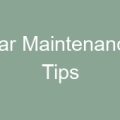Small Engine Maintenance

Small engine maintenance involves regular care and upkeep of engines used in equipment like lawnmowers or chainsaws. It includes tasks like oil changes, air filter cleaning, spark plug replacement, and fuel system inspection. Proper maintenance ensures optimal engine performance and longevity.
Small engine maintenance is essential to ensure the longevity and performance of your equipment. Regular engine maintenance can prevent costly repairs and breakdowns. It is important to maintain proper oil levels, clean or replace air filters, and check spark plugs regularly. Additionally, small engines should be serviced by a trained professional to ensure all components are in working order. Neglecting maintenance can lead to decreased fuel efficiency and even engine failure. By following a small engine maintenance schedule, you can prolong the life of your equipment and avoid unnecessary expenses.
| Small Engine Maintenance: Regularly clean air filters to ensure proper engine performance. |
| Small Engine Maintenance: Change oil and oil filter every 50 hours of operation. |
| Small Engine Maintenance: Inspect spark plugs and replace if necessary. |
| Small Engine Maintenance: Use fresh fuel and add fuel stabilizer for storage. |
| Small Engine Maintenance: Check and adjust carburetor settings for optimal performance. |
- Small Engine Maintenance: Keep cooling fins on the engine clean and free from debris.
- Small Engine Maintenance: Lubricate all moving parts regularly to prevent excessive wear.
- Small Engine Maintenance: Inspect and tighten all bolts and screws to avoid vibrations.
- Small Engine Maintenance: Check and adjust the ignition timing for smooth operation.
- Small Engine Maintenance: Store the engine in a dry and well-ventilated area to prevent rust.
How often should small engine oil be changed?
Small engine oil should be changed every 25-50 hours of use or at least once a year. Regular oil changes help maintain optimal engine performance and prevent damage.
It is important to use the correct type and viscosity of oil recommended by the manufacturer. Check the owner’s manual for specific instructions. Remember to drain the old oil when the engine is warm and replace the oil filter if applicable.
What are some common problems with small engines?
Some common problems with small engines include difficulty starting, rough idling, poor performance, and excessive smoke.
These issues can be caused by various factors such as a dirty air filter, clogged fuel lines, stale fuel, or a faulty spark plug. Regular maintenance, including cleaning or replacing the air filter, checking and cleaning fuel lines, and replacing spark plugs, can help resolve these problems.
How do I clean a small engine carburetor?
To clean a small engine carburetor, start by removing the air filter and disconnecting the fuel line.
Then, carefully disassemble the carburetor, taking note of the position of any small parts. Use a carburetor cleaner spray to clean the components, paying special attention to the jets, passages, and float bowl. Reassemble the carburetor and reconnect the fuel line and air filter.
Regular carburetor cleaning helps ensure proper fuel and air mixture, improving engine performance and preventing starting or running issues.
What type of fuel should I use for small engines?
Most small engines, including lawnmowers and chainsaws, require unleaded gasoline with a minimum octane rating of 87. It is important to avoid using ethanol-blended fuels.
Ethanol can cause damage to small engine components, leading to poor performance and starting issues. If ethanol-blended fuel is the only option, use a fuel stabilizer specifically designed for small engines to minimize potential damage.
How do I prevent small engines from overheating?
To prevent small engines from overheating, ensure proper air circulation around the engine by keeping the cooling fins clean and free from debris.
Regularly check the engine’s cooling system, including the radiator or cooling fan, for any signs of damage or blockage. It is also important to use the correct oil and maintain proper oil levels to prevent overheating.
Additionally, avoid running the engine at full throttle for extended periods and take breaks during prolonged use to allow the engine to cool down.
What is the recommended spark plug gap for small engines?
The recommended spark plug gap for small engines is typically between 0.020 to 0.030 inches.
It is important to check and adjust the spark plug gap regularly using a spark plug gap tool to ensure proper ignition and combustion. A larger or smaller gap than recommended can lead to starting issues and poor engine performance.
How do I clean a small engine air filter?
To clean a small engine air filter, start by removing it from the engine and tapping it gently to remove loose dirt and debris.
If the filter is still dirty, wash it with warm soapy water and rinse thoroughly. Allow the filter to dry completely before reinstalling it. Alternatively, some air filters can be replaced if cleaning is not effective.
A clean air filter is essential for proper airflow and combustion, ensuring optimum engine performance and longevity.
What is the proper way to store small engines during the off-season?
Proper storage of small engines during the off-season helps prevent damage and ensures easier starting when they are needed again.
Start by draining the fuel tank and running the engine until it is out of fuel. Change the oil and replace the spark plug. Clean the engine and remove any debris or grass clippings. Store the engine in a dry, well-ventilated area, away from extreme temperatures and moisture.
How do I troubleshoot a small engine that won’t start?
If a small engine won’t start, check for common issues such as a clogged air filter, stale fuel, or a faulty spark plug.
Ensure the fuel line is clear and the fuel is fresh. Clean or replace the air filter and check the spark plug for signs of wear or damage. If necessary, clean or replace the spark plug and ensure the spark plug wire is securely connected.
If the engine still won’t start, it may be necessary to seek professional assistance.
What are the signs of a worn-out small engine piston ring?
Signs of a worn-out small engine piston ring include loss of power, excessive oil consumption, and blue smoke from the exhaust.
If the piston ring is worn, it may not create a proper seal, leading to reduced compression and performance. In such cases, it is necessary to replace the piston rings to restore optimal engine operation.
How do I clean a small engine fuel tank?
To clean a small engine fuel tank, start by removing any fuel and disconnecting the fuel line.
Rinse the tank with a mixture of warm, soapy water and let it sit for a few minutes. Scrub the inside of the tank with a brush to remove any residue or debris. Rinse the tank thoroughly and allow it to dry completely before refilling with fresh fuel.
Cleaning the fuel tank helps prevent fuel contamination and ensures proper fuel flow to the engine.
What is the proper way to check and adjust small engine valve clearance?
To check and adjust small engine valve clearance, start by removing the valve cover.
Rotate the engine to the top dead center of the compression stroke and insert a feeler gauge between the valve stem and rocker arm. The correct clearance should be specified in the engine’s service manual. If adjustment is needed, loosen the lock nut and use a screwdriver to turn the adjuster until the correct clearance is achieved. Retighten the lock nut and recheck the clearance.
Proper valve clearance ensures efficient engine operation and prevents valve damage.
How do I troubleshoot a small engine that runs rough?
If a small engine runs rough, it may be due to issues such as a dirty carburetor, clogged fuel lines, or a faulty ignition system.
Start by cleaning or rebuilding the carburetor, ensuring all jets and passages are clear. Check and clean the fuel lines and replace any damaged or clogged parts. Inspect the ignition system, including the spark plug and ignition coil, for any faults. Adjust the engine’s idle speed and mixture if necessary.
If the problem persists, it may be necessary to seek professional assistance.
What are the steps to winterize a small engine?
To winterize a small engine, start by adding a fuel stabilizer to the fuel tank and running the engine for a few minutes to distribute the stabilizer.
Change the oil and replace the spark plug. Clean the engine and remove any debris or grass clippings. Drain the fuel tank and run the engine until it is out of fuel. Store the engine in a dry, well-ventilated area, away from extreme temperatures and moisture.
Proper winterization helps protect the engine from damage during the cold months.
How do I replace a small engine pull cord?
To replace a small engine pull cord, start by removing the starter assembly from the engine.
Unwind and remove the old cord, then wind the new cord onto the pulley, ensuring it is tightly wound and properly aligned. Thread the new cord through any guide holes and tie a secure knot at the end. Reassemble the starter assembly and test the pull cord for proper operation.
Regular maintenance of the pull cord ensures reliable starting of the engine.
What are the signs of a dirty small engine fuel filter?
Signs of a dirty small engine fuel filter include engine stalling, difficulty starting, and poor performance.
If the fuel filter is clogged or dirty, it can restrict fuel flow to the engine, leading to these issues. Regularly inspect and replace the fuel filter as recommended by the manufacturer to ensure proper fuel delivery and protect the engine from damage.
How do I adjust the idle speed on a small engine?
To adjust the idle speed on a small engine, locate the idle speed adjustment screw.
Start the engine and let it warm up. Turn the idle speed screw clockwise to increase the idle speed or counterclockwise to decrease it. Adjust the screw in small increments and listen for changes in engine rpm. Once the desired idle speed is achieved, tighten the locking nut to secure the adjustment.
Proper idle speed adjustment helps prevent stalling and ensures smooth operation of the engine.




















